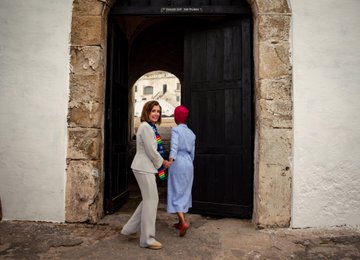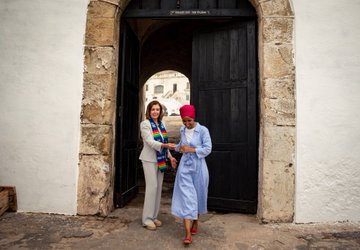
Debra Santos (blue scarf), an Atlanta Airbnb host, who is visiting Ghana as part of that nation’s “Year of the Return.” African Americans have been encouraged to return to Africa this year to mark 400 years of slavery. “My face says it all,” Santos said of the photograph, taken in an Elmina Castle dungeon where dozens of female captives would have been held before departing into slavery.
EXCLUSIVE: Centuries later, Atlantans make trip to Ghana’s “Door of No Return”
King Historical Site, APEX team up to bring grim reminder home
For many thousands, it was the last glimpse of Africa.
Through a door, made narrow so that they would have to walk through in single file, Africans trudged out of the darkness of Ghana’s Elmina Castle or nearby Cape Coast Castle into the blinding sunlight bouncing off the Atlantic Ocean. Then they were chained and stacked like cordwood onto awaiting boats.
That “Door of No Return” was the grim gateway west to a life of enslavement in Brazil, the Caribbean, and America.
“When you walk out of that door today, even now, it is terrifying,” said Debra Santos, an Atlantan visiting Ghana now. “So they had to be terrified to look out in the distance and see no land and know they weren’t coming back.”
But thousands of African Americans have made the trip back to Ghana in recent months. Many have traveled from Atlanta, which has one of the largest Ghanaian populations in the U.S.
Ghana, part of the Gold Coast, a major departure point during the slave trade, recently launched “The Year of Return” campaign. The country, still coming to terms with the role Africans played in the capture and sale of Africans, as well as slavery’s impact on the nation’s development, is urging American descendants of slaves to return home even for just a few days.

At the same time, as America marks 400 years since the first African slaves arrived in the U.S., Atlanta’s Martin Luther King Jr. National Historical Park is trying to acknowledge what that door means in the starkest of ways. As part of a new exhibition entitled “400 Years” that opened Aug. 26, a giant photo of a door and mannequins of slaves greet tourists in the atrium.
A block down Auburn Ave., as part of the exhibition, the African-American Panoramic Experience (APEX) Museum, the city’s oldest black cultural repository, is exhibiting “Africa: The Untold Story.” In that more detailed account, visitors can walk through a life-sized replica of “Door of No Return.”
The exhibitions, a glimpse into the Middle Passage and American slavery, are being described by the park and museum as a “journey over four centuries to America and hopes as a people, past and present, for racial equity and healing.”

Last week, standing outside the door replica, Dan Moore, who founded the APEX in 1978, watched silently as visitors tentatively walked in and were bombarded with a recording of waves, mixed in with screams and the shuffling of chains.
“Everybody that I have talked to, who has visited the actual Door of No Return, tell me that when they walk into that space, they can feel the presence of their ancestors,” Moore said. “Nothing was as horrific as the slavery that the Europeans modeled. They stripped Africa of its culture, its religion, its resources, its people.”
From ‘20 and odd’ Negroes to 12 million
On Aug. 26, 1619, the first Africans to arrive as slaves on American shores landed in Port Comfort, Virginia. Those “20 and odd Negroes” created the foundation for more than 200 years of chattel slavery in America.
It will never be known how many Africans were captured and stolen from Africa, but it is estimated that more than 12 million of them were shipped across the Atlantic over a span of 400 years. Roughly 389,000, or about 3% of the enslaved, landed in America.

“The transatlantic slave trade represents the most tragic episode in human history,” said Osagyefou Amoatia Ofori Panin, the king of Kyebi, in Ghana’s Eastern region. “It explains many things, but most importantly the material underdevelopment and the destruction of the communal and humanist social and cultural fabric of African society. The transatlantic slave trade opened the door for colonization and conquest of Africa.”
With “The Year of Return” campaign, “we can rewrite history,” Panin told The Atlanta Journal-Constitution. “Africans in the diaspora have a role to play in rebuilding the continent.”
Anxiety and horror
Santos, the Atlantan, made that journey home, setting foot on African soil for the first time on Aug. 20. She was traveling with a group of fellow black Airbnb hosts. They have all returned home. She has extended the trip on her own indefinitely, touched by a crowd of Ghanaians who hugged and rubbed her face when she arrived.
“They kept saying, ‘welcome home, we missed you,’” Santos said. “I don’t know if I had ever felt the spirit, the African spirit, until that very moment. It was awe-inspiring. America is the love of my heart, but Ghana is the love of my soul.”
Still, nothing could have prepared her heart and soul for the rest of the trip.

On Ghana’s coast, Santos visited Elmina Castle and the Cape Coast Castle.
Generally known as holding spaces for captured Africans, it will never be known exactly how many came through the two ports, through the doors and onto ships bound for slavery.
At Elmina, Santos was ushered into a dungeon where women captives were held. By today’s standards, one of the dungeons should probably hold about 30 people. More than 150 would be packed in, with a single window to circulate the dense, hot air, according to historical accounts. Those who survived were carted onto boats.
“When we went to the dungeon, they turned the lights off,” said Santos, who has traced her roots to nearby Ivory Coast. “I had a major anxiety attack. You can feel and sense how horrible it could have felt back then. I did not expect to be so emotional.”
Like outer space
Arletha Livingston knows the feeling.
The director of the Morehouse School of Medicine’s Innovation Lab, Livingston has been going to countries in Africa since 1995, and every trip to Ghana is emotional.
In early August, she tagged along with her sister, a trauma specialist, who guided members of the Congressional Black Caucus, including House Speaker Nancy Pelosi and U.S. Rep. Ilhan Omar (D-Minn), through the castles and dungeons.













































 Atlanta Beltline supporter Rick Hudson asks questions during a recent public forum on MARTA’s proposed Atlanta expansion. Supporters for various projects are jockeying to be included in the final project list. STEVE SCHAEFER / SPECIAL TO THE AJC (The Atlanta Journal-Constitution)
Atlanta Beltline supporter Rick Hudson asks questions during a recent public forum on MARTA’s proposed Atlanta expansion. Supporters for various projects are jockeying to be included in the final project list. STEVE SCHAEFER / SPECIAL TO THE AJC (The Atlanta Journal-Constitution)
 This MARTA presentation shows the major transit improvements proposed for the “More MARTA” program approved by Atlanta voters in 2016. The projects include light rail (yellow), bus rapid transit (blue) and arterial rapid transit (red) lines. Not pictured: Local bus improvements, new bus transfer stations and renovation of numerous existing transit stations. SOURCE: MARTA. (The Atlanta Journal-Constitution)
This MARTA presentation shows the major transit improvements proposed for the “More MARTA” program approved by Atlanta voters in 2016. The projects include light rail (yellow), bus rapid transit (blue) and arterial rapid transit (red) lines. Not pictured: Local bus improvements, new bus transfer stations and renovation of numerous existing transit stations. SOURCE: MARTA. (The Atlanta Journal-Constitution)
 Charnette Trimble walks to her office space from MARTA’s Five Points stop. She is a community activist from southwest Atlanta who is advocating for the proposed Campbellton Road light rail line.
Charnette Trimble walks to her office space from MARTA’s Five Points stop. She is a community activist from southwest Atlanta who is advocating for the proposed Campbellton Road light rail line.
You must be logged in to post a comment.